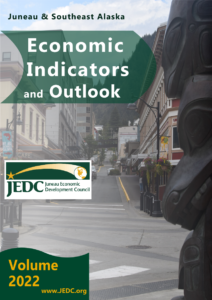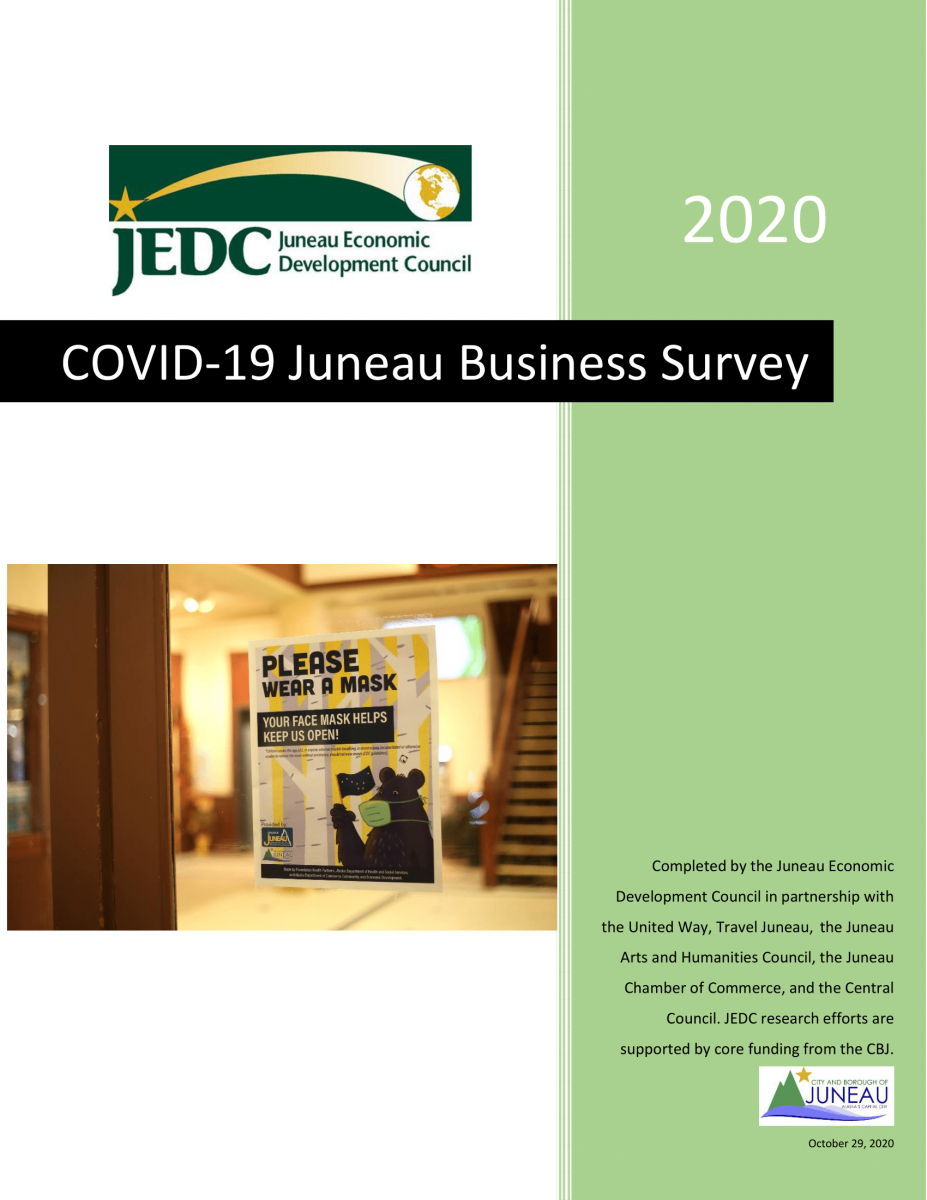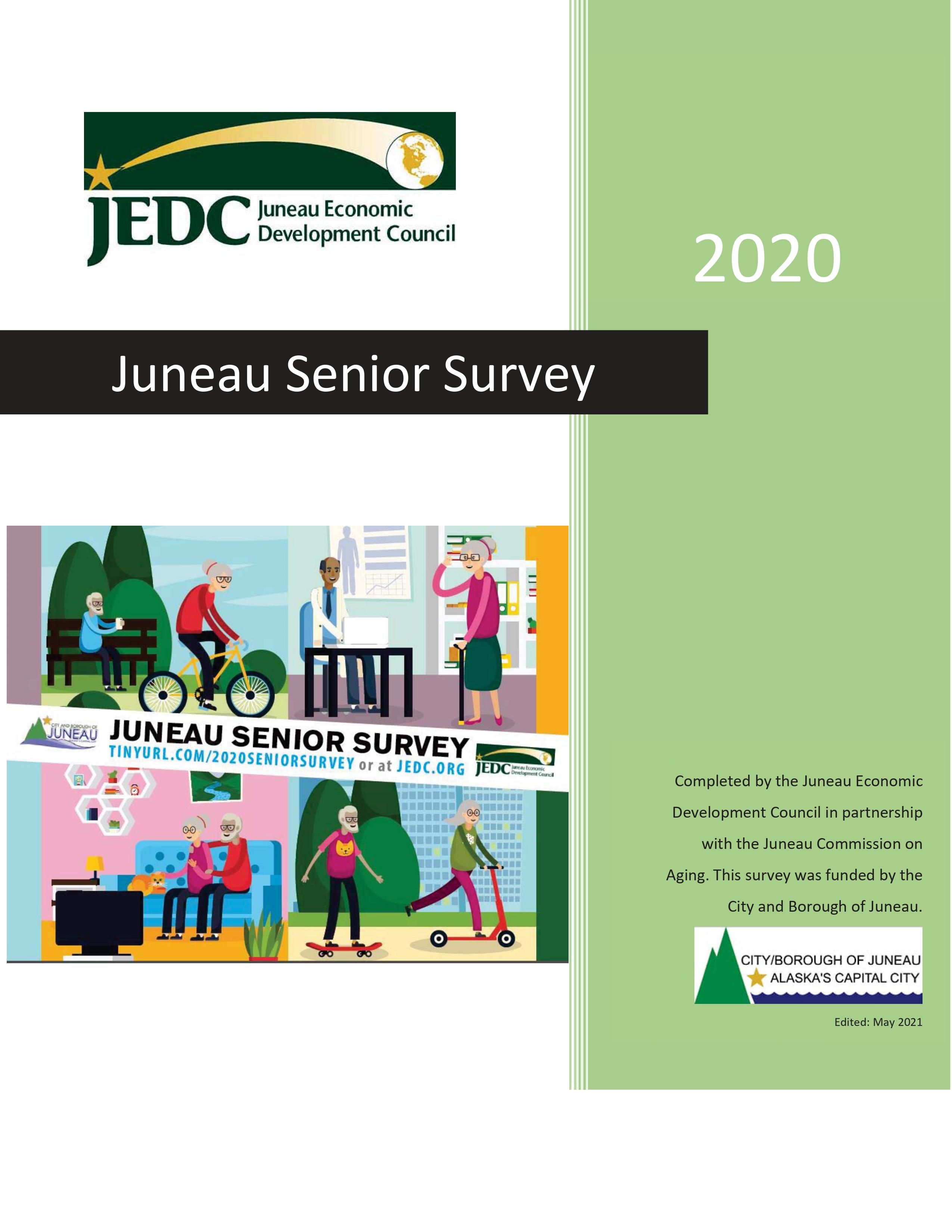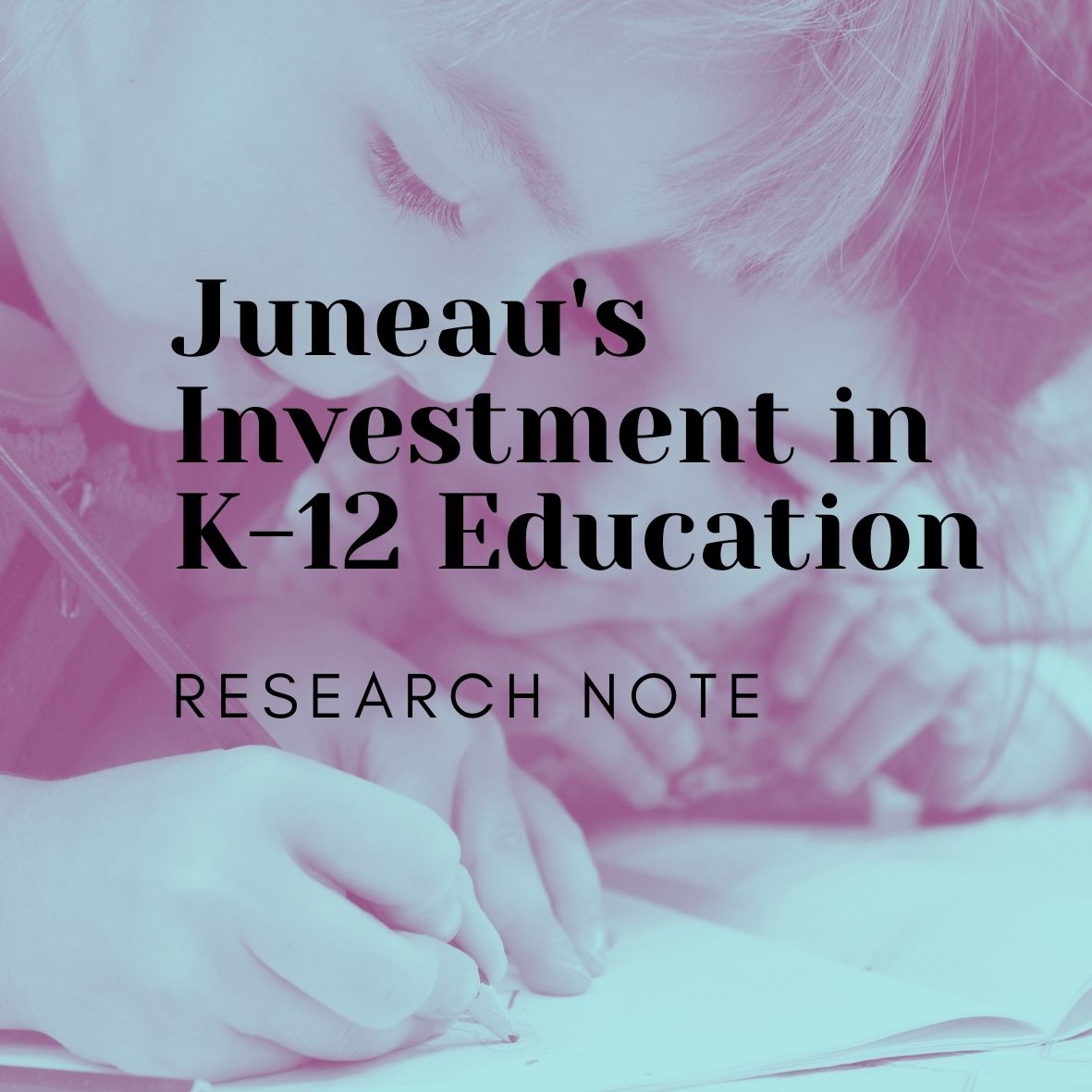Cluster Co-Chairs: Dave D’Amore, USFS, and Shannon Atkinson, UAF/UAS
Highlights
- Convening since 2013, The Research and Development Cluster Working Group has achieved improved lines of communication between research entities in the region, resulting in integrated collaborative programs that have advanced research work.
- The Cluster Working Group established recognition for Southeast Alaska as a Community of Excellence in Research.
- The Cluster Working Group published a report highlighting research needs in rural Southeast communities.
A review of Research and Development Cluster Working Group initiatives is found below.
Become State Committee on Research (SCoR) Area of Excellence
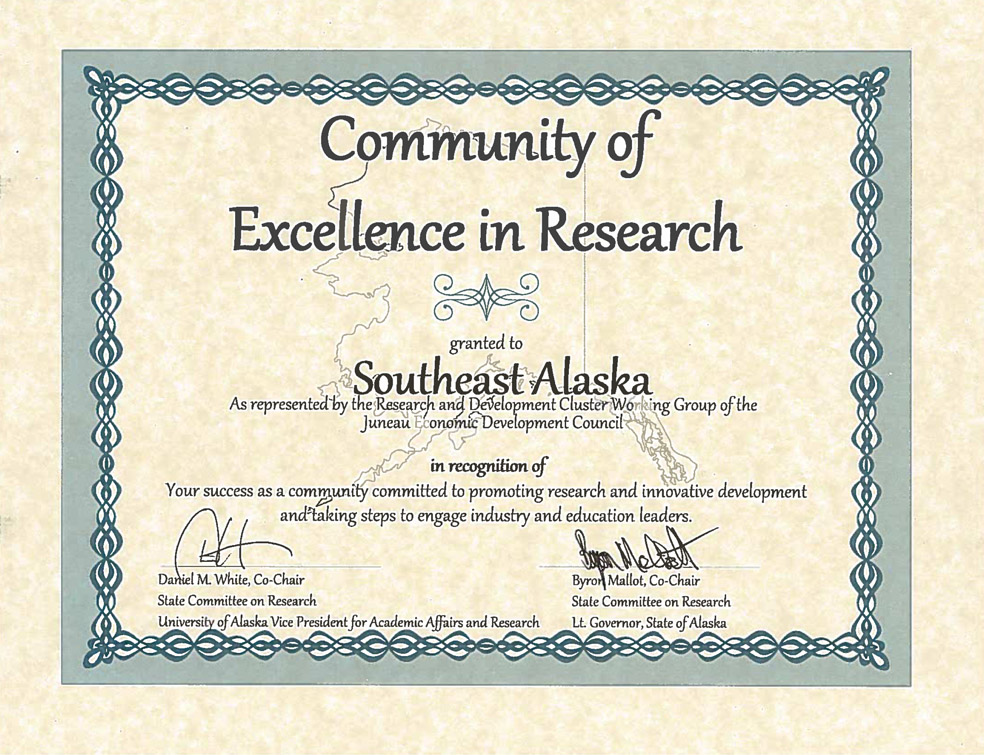 To Build a Fire: The Alaska Science and Technology Plan, developed by the State Committee on Research (SCoR), is an important step in giving direction to the critical research effort needed for science and technology innovation that will insure Alaska’s continued prosperity. Key to the plan’s ultimate success is cooperation between government, academia, research groups, businesses, and nonprofit organizations in implementing the policy directives outlined in the Report. The purpose of this initiative was to establish recognition for Southeast Alaska, through the Research and Development Cluster Working Group, as a model for coordination of research entities and engagement of industry and educational leaders in promoting research and innovative development in the region.
To Build a Fire: The Alaska Science and Technology Plan, developed by the State Committee on Research (SCoR), is an important step in giving direction to the critical research effort needed for science and technology innovation that will insure Alaska’s continued prosperity. Key to the plan’s ultimate success is cooperation between government, academia, research groups, businesses, and nonprofit organizations in implementing the policy directives outlined in the Report. The purpose of this initiative was to establish recognition for Southeast Alaska, through the Research and Development Cluster Working Group, as a model for coordination of research entities and engagement of industry and educational leaders in promoting research and innovative development in the region.
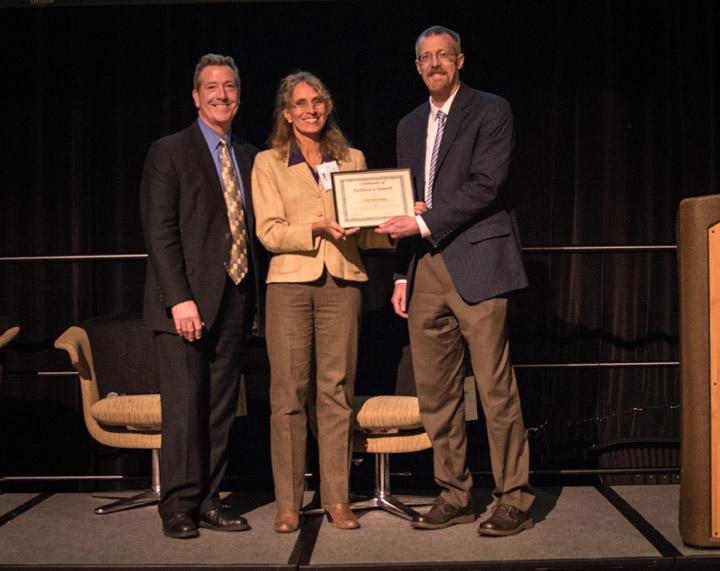 Dr. Daniel M. White from the Statewide Committee for Research, presents the Southeast Research & Development Cluster Working Group co-chairs, Dave D’Amore and Shannon Atkinson, with the certificate that recognizes Southeast Alaska as a Community of Excellence in Research.
Dr. Daniel M. White from the Statewide Committee for Research, presents the Southeast Research & Development Cluster Working Group co-chairs, Dave D’Amore and Shannon Atkinson, with the certificate that recognizes Southeast Alaska as a Community of Excellence in Research.- In 2014 the champion for this initiative and JEDC staff met with the State Co-Chair of SCoR and requested guidance on how to have Southeast Alaska officially designated as a Community of Excellence in Research. The R&D working group Co-chairs submitted a formal request to SCoR and received notification of recognition as Alaska’s first “Community of Excellence in Research” on September 2, 2015.
- At the 2016 Innovation Summit Dr. Dan White from the Statewide Committee on Research presented the Research & Development Cluster Working Group co-chairs, Dave D’Amore and Shannon Atkinson, with a certificate that recognizes the designation of Southeast Alaska as a Community of Excellence in Research. The Juneau Economic Development Council along with Sitka Sound Science Center shared this news to regional press. A picture and write-up was featured in the Juneau Empire’s Neighbors section, along with letters in Sitka, Ketchikan and Skagway. A story on the designation and presentation was run in the Juneau Empire on March 13, 2016.
- The Statewide Committee on Research co-chairs, Dr. Daniel M. White and Lt. Governor Byron Mallott, signed multiple copies of the designation certificate. The framed certificates were delivered to the Sitka Sound Science Center, UAF School of Fisheries and Ocean Sciences at Lena Point, UAS Juneau campus, USFS Juneau Forestry Sciences Laboratory, and the Ted Stevens Marine Research Institute facility, to be put on display in a public location.
- In 2016, the group worked to bring statewide attention to innovators in Southeast Alaska through nominations to the Alaska Innovators Hall of Fame. Three Southeast nominations were successfully submitted.
- JEDC, in collaboration with the Fairbanks Economic Development Corporation, wrote a letter to the media to encourage support for investing in education and research at the University of Alaska, which was picked up by papers in Fairbanks, Juneau, Anchorage and Kenai. The commentary appeared in the Alaska Dispatch News on March 6, 2016.
- Brian Holst, JEDC Executive Director, was invited to serve on the State Committee on Research. He began his three-year term of service in February 2016. JEDC’s Executive Director also serves on the Alaska Coastal Rainforest Center steering committee.
Connect Research to Communities
A short survey was conducted in Southeast Alaska communities to provide some insight into what types of research are being conducted in the Eastern Gulf of Alaska and what research could benefit communities in the region. The survey was intended to also strengthen awareness of community research needs and create baseline information for connecting researchers with community issues.
- In 2013, a draft survey was developed and piloted to determine what types of research was being conducted in communities across Southeast Alaska, where research is being collected, community capacity for conducting research, and ultimately to determine what research is needed in Southeast Alaska. Informed by the pilot survey, in early 2014 the survey was revised and a strategy for conducting the survey was developed.
- Survey responses were collected in 2014 from 42 respondents with 18 of 33 communities represented. The final report was released in 2016. There are several findings regarding research areas that are of interest to communities. The top three community research interests are fisheries, alternative energy, and economy. Communities reported several research areas including: timber, alternative energy, agriculture, tourism, and the ferry systems. Communities reported a lack of adequate research facilities, workforce, and accommodations. This initiative has been retired with the release of the report.
Develop a Collaborative Research Network Focused on Key Themes in Southeast Alaska
The goal of this initiative was to improve regional communication and coordination regarding research and development opportunities and needs in Southeast Alaska. The initiative achieved improved lines of communication between research entities in the region, resulting in integrated collaborative efforts among Federal and State agencies, the University of Alaska, and centers at both UAS and UAF, leading to collaborative research programs that have advanced research work in climate change, carbon cycle science, fisheries, and wood products. Some key collaborations are:
- 2013 and 2014 saw the creation and continuation of a first of its kind bi-weekly seminar series to highlight regional research, bringing scientists, students, resource managers and industry representatives together for collaborative discussions and brainstorming. The program has since been put on hold.
- The USFS PNW Research Station, the Alaska Coastal Rainforest Center and the BC Ministry of Forests and Natural Resource Operations have jointly undertaken a hydrologic study to model snow and streamflow across the entire region.
- The USGS Climate Science Center, the UAF Scenarios Network for Alaska and Arctic Planning and the PNW Research Station have a collaborative agreement to model soil hydrologic conditions in the region. This project has a close link with Yellow-cedar decline related research and will provide information on soil conditions that influence productivity and health of vegetation communities.
- The PNW Research Station is hiring a new fisheries biologist to address the important restoration and management of salmonids in Southeast Alaska. This new position will enhance the research capacity of the region.
- The PNW Research Station is leading the regional carbon accounting for coastal forest region in collaboration with the USGS Landcarbon program and UAF. This study is providing the stock and flux of carbon in the region for reporting to the UN to monitor greenhouse gas emissions and mitigation around the world.
- The Alaska Coastal Rainforest Center (ACRC) was awarded a five-year, $500,000 Coastal Rainforest Margins Research Network grant from the National Science Foundation to facilitate scientists and stakeholders to study the interface between land and ocean, where fresh water and nutrients flow downstream from coastal watersheds into the nearshore marine environment. The goal is to leverage the research network into other collaboration opportunities.
- In 2015, the Cluster Working Group developed an outline of the services needed by the Research and Development community. The cluster group identified as a priority the need to expand research capacity in the region. In response, JEDC subscribed to the SSTI (State Science and Technology Institute) Funding Supplement Newsletter and distributes this weekly publication to the Cluster Working Group members. This publication lists nation-wide funding opportunities with a technology transfer focus. As a result of this information, the Cluster Working Group Co-Chair (and researcher at UAF’s SFOS Juneau campus) became aware of availability of a Cooperative Science Centers at Minority Serving Institutions Focused on Issues Related to Oceanic and Atmospheric Research grant. Upon exploring the possibility of submitting a grant request for the UAF School of Fisheries and Ocean Sciences (SFOS), it was determined that the UAF had not solicited federal designation as a Minority Serving Institution and thus was ineligible for these, and other similar, grant funds. Consequently, the SFOS partnered with UC Riverside to submit a grant request to establish a Pacific Coast Cooperative Science Center for Coastal and Marine Ecosystems. If awarded, approximately $2.2 million would come to the University of Alaska from a total $15 million grant.
Market the Unique Geographic, Natural and Infrastructure Features of our Region
The objective of this initiative is to strengthen relationships within the existing regional network of research facilities in Southeast Alaska, elevate network visibility and profiles, make improvements in local infrastructure, and adopt institutional practices that allow sharing of facilities and logistics support.
- In 2014 the initiative team embarked on a targeted marketing campaign with networking and research trips to Fairbanks, Anchorage, Vancouver, Seattle, Portland, and Washington DC.
- In 2016 the Cluster Working Group networked with research field stations and other research entities operating in Southeast Alaska. The group connected with the Director of the Inian Islands Institute and the Alaska Whale Foundation’s Center for Coastal Conservation to see how they could further the research and outreach agenda for these newly developed field stations. The group connected with the Chair of the research subcommittee of the Governor’s Mariculture Task Force, and had a sharing of information with the State of Alaska’s Chief Fisheries Scientist for ADF&G and the Regional Supervisor, Sport Fish Division. Bob Janes and Linda Micklin gave a presentation on plans for a Juneau Ocean Center on Juneau’s waterfront. Exhibits will focus on interpreting Alaska’s oceans for tourists, with a marine mammal focus.
Promote STEM Education in our Region
The goal of this initiative is to augment STEM literacy in the regional education system by expanding STEM out-of-school learning opportunities for K-12 and post-secondary students. The vision is for more local research scientists to play a role in delivering STEM education.
- In 2013 the initiative attempted to integrate STEM professionals into school programs, first the RALLY program, and subsequently into classrooms through an Engineering is Elementary (EiE) curriculum. The RALLY program was determined to not be an effective starting point for the integration of STEM professionals.
- In 2014 work continued to integrate STEM professionals into school programs and into classrooms through an Engineering is Elementary (EiE) curriculum and after-school through a 21st Century grant with support of JEDC and the Juneau School District. STEM efforts also included activities through the middle-school After School Coalition in Juneau.
- In 2016 the group connected with and received an update on the STEM resources community database for the Juneau School district. There are now 40 people in the database. The goal is to facilitate a match between community volunteers and teacher needs. Harborview and Riverbend are piloting its use.
Link industry needs to local researchers in Southeast Alaska
The goal of this initiative is to leverage existing networks and create new ones in order to raise awareness among community stakeholders of the diverse capabilities and availability of research in our region. This initiative focused on the small-scale timber industry in Southeast Alaska, investigating the potential for local mills to create value-added products from yellow-cedar trees killed by long-term changes in weather patterns. With the PNW Research Station, Alaska Coastal Rainforest Center, the State of Alaska Division of Forestry and DCCED now collaborating on a project to explore the feasibility of utilizing dead yellow-cedar in Southeast Alaskan forests as a source of highly valuable wood, this initiative has been put on hold.
